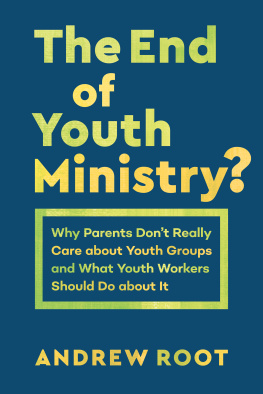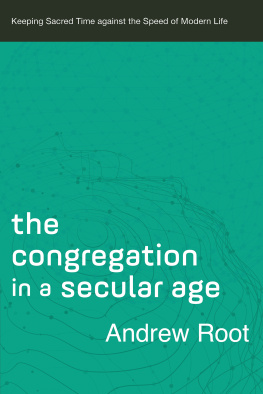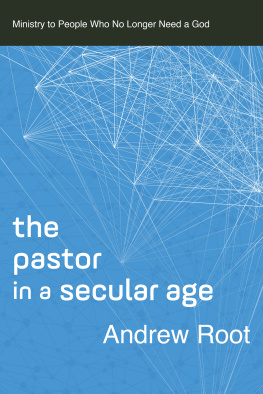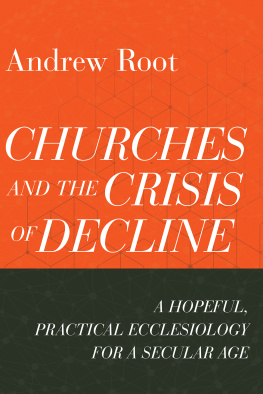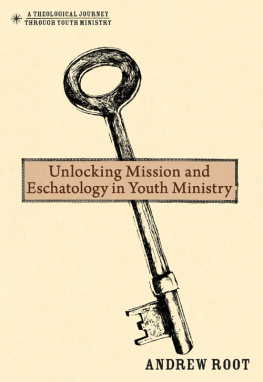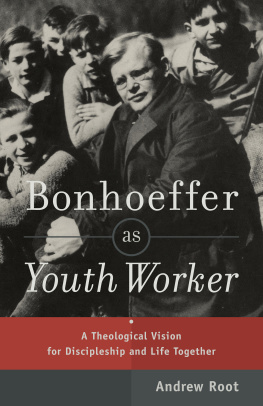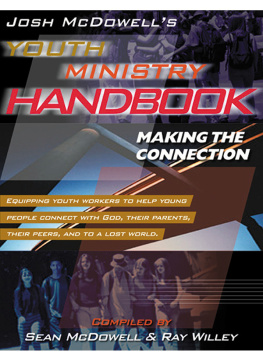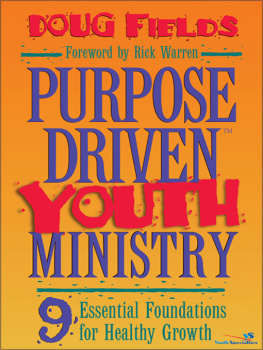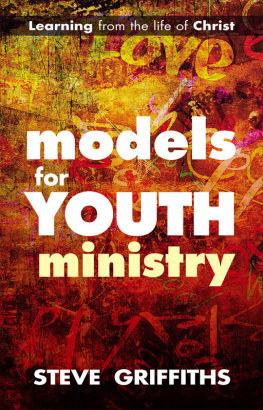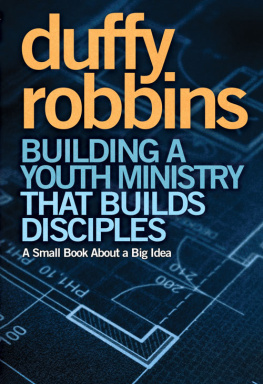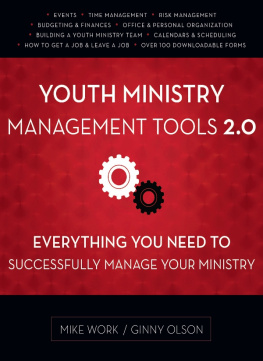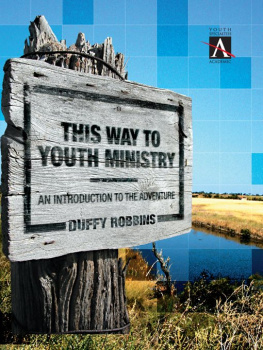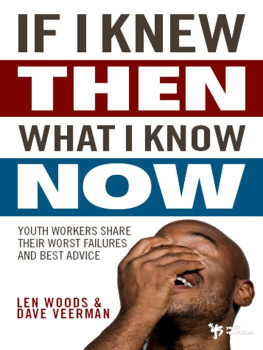Endorsements
Root has made a career out of challenging the youth ministry industry, but this is his most important youth ministry book to date. The end of youth ministry? Hardly. This is where it starts.
Kenda Creasy Dean , Princeton Theological Seminary; author of Almost Christian: What the Faith of Our Teenagers Is Telling the American Church and coauthor of Delighted: What Teenagers Are Teaching the Church about Joy
Andy calls us back to the cross by inviting young people to identify with Christs death and thus experience Gods action in their lives. Rather than busyness, silence and humility make way for gratitude, and genuine joy erupts.
Sharon Galgay Ketcham , Gordon College; author of Reciprocal Church
Sometimes the riskiest questions we ask return us to the most basic ones. Andys quest to answer What is youth ministry for? invites us to join his own journey of theological and self-reflection. This book dares us to reorient our youth ministry approaches away from cultivating happiness and toward Christ crucified.
Steven Argue , Fuller Theological Seminary
There are nagging questions in youth ministry, many of which we hesitate to name out loud. Does what Im doing matter? Is any of this making a difference? In The End of Youth Ministry? , Root manages to put his finger on these concerns and bring them into the light. He doesnt just name these questions, he explores them at length and then returns them to the youth worker in such a way that the questions become gifts.
Amanda Hontz Drury , author of Saying Is Believing: The Necessity of Testimony in Adolescent Spiritual Development
Roots many books evince a learned and sustained engagement with some of the most important thinkers in biblical studies, theology, philosophy, social theory, and more. His latest work, The End of Youth Ministry? , is no different, though its methodology is refreshingly new.
Bryan C. Hollon , Malone University
Series Page
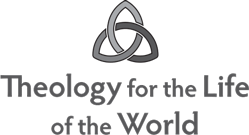
Jesus Christ is God come to dwell among humans, to be, to speak, and to act for the life of the world (John 6:51). Taking its mandate from the character and mission of God, Christian theologys task is to discern, articulate, and commend visions of flourishing life in light of Gods self-revelation in Jesus Christ. The Theology for the Life of the World series features texts that do just that.
Human life is diverse and multifaceted, and so will be the books in this series. Some will focus on one specific aspect of life. Others will elaborate expansive visions of human persons, social life, or the world in relation to God. All will share the conviction that theology is vital to exploring the character of true life in diverse settings and orienting us toward it. No task is greater than for each of us and all of us together to discern and pursue the flourishing of all in Gods creation. These books are meant as a contribution to that task.
Title Page
Copyright Page
2020 by Andrew Root
Published by Baker Academic
a division of Baker Publishing Group
PO Box 6287, Grand Rapids, MI 49516-6287
www.bakeracademic.com
Ebook edition created 2020
All rights reserved. No part of this publication may be reproduced, stored in a retrieval system, or transmitted in any form or by any meansfor example, electronic, photocopy, recordingwithout the prior written permission of the publisher. The only exception is brief quotations in printed reviews.
Library of Congress Cataloging-in-Publication Data is on file at the Library of Congress, Washington, DC.
ISBN 978-1-4934-2017-9
Unless otherwise indicated, Scripture quotations are from the Holy Bible, New International Version. NIV. Copyright 1973, 1978, 1984, 2011 by Biblica, Inc. Used by permission of Zondervan. All rights reserved worldwide. www.zondervan.com. The NIV and New International Version are trademarks registered in the United States Patent and Trademark Office by Biblica, Inc.
Scripture quotations labeled RSV are from the Revised Standard Version of the Bible, copyright 1946, 1952 [2nd edition, 1971] National Council of the Churches of Christ in the United States of America. Used by permission. All rights reserved worldwide.
Dedication
To Skip Masback:
In gratitude for your friendship and for a career of championing youth ministry
Contents
Cover
Endorsements
Series Page
Title Page
Copyright Page
Dedication
Warning for the Reader! (Read before Using)
Preface
1. Toward a Journey to Joy
LATE MARCH
2. Dont Waste Your Life: Youth Ministry and the Good Life
SEPTEMBER
3. Are the Kids OK? Goods and Youth Ministry
SEPTEMBER
4. Three Sets of Parents: Things and Happiness Emerge
LATE OCTOBER
5. Identity, Part 1: A Dance Party, Demi Lovato, and the Internal Quest
LATE OCTOBER
6. Transformation in Youth Ministry
LATE MARCH
7. Identity, Part 2: Romance, Recognition, and Resentment
LATE OCTOBER
FROM WINTER TO SPRING BREAK
9. When Goods Become the Good
LATE MARCH
10. Happiness, Part 2: Holiness, Virtue, and Luthers Freak-Out
THE END OF SPRING BREAK
11. Joy and the Custodian: What Youth Ministry Is For
LATE MARCH
12. Borne Burdens: Youth Ministry and Stories of Joy
LATE MARCH
13. Open Takes and Closed Spins: Youth Ministry and Transcendence
LATE MARCH
14. An Identity Event: How Youth Ministry Affects Identity
MID-APRIL
15. Holding Vigil: Youth Ministry and Cruciform Practices
MAY
Conclusion: Friendship and DQ
MAY
Back Cover
Warning for the Reader!
(Read before Using)
A s you pick up this book and page through it, a good question is, What is this? Ill be the first to admit that its weird. Ive written it in the first person, as a story that I, Andrew Root, am going through. And in a real way, I am. Writing this book has forced me to think in new ways, connecting new thoughts to my earlier projects. In no small way, this book is the outworking of the implications of my Faith Formation in a Secular Age . It even offers a vision for how I think attention to the good life and the practices of faith connect to place-sharing and the theology of the cross, both of which my earlier thoughts rest on so squarely.
That said, the story that unfolds below is a parable, a kind of thought experiment. The best way to say it is that this book is written in the spirit of the Christian philosopher Sren Kierkegaard. All of my works have more than a hint of Kierkegaardian influence. Like Kierkegaard, who Karl Barth called the melancholy Dane, I sometimes feel like I could be called a melancholy Minnesotan. Perhaps both Kierkegaard and I have spent far too much time in snowdrifts and bone-chilling winds to see the world in any other way than through the crucifixion. So with Kierkegaardian irony, youll be surprised to discover that this book is fundamentally about joy . It sketches out how I see joy as central to inistry, and how I see joy in the resurrection as essential to a theology of the cross.
But in this book I go further in my Kierkegaardian directions than I have before, taking on the Danes style, using stories that mix factual occurrences and made-up characters to articulate larger points about reality. For half a second I even thought of using a Kierkegaardian pseudonym (Crash Adams would have been cool), but I resisted the temptation. So instead Im calling the protagonist of the tale ahead Andrew. The character Andrew is on a nine-month journey to figure out what youth ministry is for. Just as Kierkegaards two characters Judge Vilhelm and A in Either/Or serve as a way for the philosopher to push forward new ideas, so my characters do as well.

